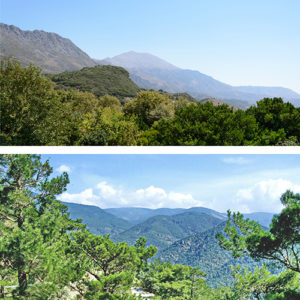§0. This brief set of comments is about two enormous mountain-ranges. One of the two dominates the central zone of the island of Crete and the other, the Plain of Troy. Both of these massive highlands were called Ida in the ancient world. And my comments here center on the picturing of an eagle soaring down from the heights of Mount Ida, bearing messages for the lowlanders below.

Bottom: Mount Ida (known locally as Kazdağı) in Asia Minor, which overlooks the site of Troy. Photo via Wikimedia Commons.
§1. The point of departure for my comments here is the Mount Ida that is situated in Crete. My story begins with a ceremony that took place on the third of December, 2021, in the university town of Rethymno in Crete. I was attending this ceremony long-distance—flown in, as it were, from across the ocean by way of the current world’s technological marvels. And there I was, notionally present in Crete, as I heard a most enchanting song being performed by master musicians, native sons of this proud old island, on the occasion of the ceremony that I was attending. Here is a link to a recording of the whole ceremony, https://youtu.be/ZudFzVjmD0I, and I focus on an exquisite moment that I could hear and visualize starting at minute 47 of the performances as recorded and time-stamped. At that moment, you can hear the song of the master musicians picturing the flight of an eagle as it soars down from the heights of Psiloríti, meaning ‘the towering heights’—which is the name of Mount Ida in the Greek language as spoken in Crete nowadays.
§2. And I connect this moment with another moment. I now offer a point of transition to the other Mount Ida, looming over the Plain of Troy. My story now continues with an event that takes place in the timeless past of epic time. It happens in Iliad 24, verses 305 to 321, where the proud old king of Troy, Priam, is praying to Zeus, invoked as the god who dominates from his lofty abode on top of Mount Ida the lowlands of the Plain of Troy. Priam prays to Zeus on high to send down to him a message of a good omen, conveyed by an eagle, described as the favorite bird and designated messenger of the god. Sure enough, an eagle soars down from the heights above, crossing the field of vision from left to right and thus signaling a successful answer to the old man’s prayer.
§3. Already in ancient times, commentators on Homeric poetry were puzzled by references to Mount Ida as the abode of Zeus not only in contexts where a Trojan persona is praying to the god, as we have just seen in the example of Priam’s prayer, but even in contexts where the persona who is praying to Zeus is not Trojan but Achaean. A notorious example is a passage in Iliad 3, verse 276, where Agamemnon, leader of all the Achaeans, is praying to Zeus as abiding on top of Mound Ida, not on top of Mount Olympus.
§4. For a more detailed project, I plan to analyze further such Homeric contexts where Achaeans think of Zeus as abiding on Mount Ida, and I will connect my analysis with earlier projects of mine where I derive such a mode of thinking from an Iliadic tradition that is localized in Asia Minor.
§5. The groundwork for such earlier projects of mine can be found in Homer the Preclassic (Nagy 2010:182), where I analyze the Homeric narrative in Iliad 14, verses 282 to 293. The visualization of the landscape here, as the narrative views the goddess Hērā traveling toward Mount Ida, corresponds to what you would see if you looked due north while standing on the north shore of the island of Lesbos. Across the sea, beyond the strait separating this island from the mainland of Asia Minor to the north, is the skyline of the region leading uphill to the heights of Mount Ida. Just as you are looking north from the north shore of Lesbos when you see that skyline, so also Hērā is traveling north as she hastens to arrive at her point of assignation with the mighty thunderer on the peaks of Mount Ida. This view from Lesbos, I argue, shows an Aeolian poetic vantage point in visualizing the narrative space of Troy in its entirety.
Bibliography
Nagy, G. 2010|2009. Printed|Online version. Homer the Preclassic. Berkeley and Los Angeles. http://nrs.harvard.edu/urn-3:hul.ebook:CHS_Nagy.Homer_the_Preclassic.2009.
Nagy, G. 2013. The Ancient Greek Hero in 24 Hours. Cambridge, MA. http://nrs.harvard.edu/urn-3:hul.ebook:CHS_NagyG.The_Ancient_Greek_Hero_in_24_Hours.2013.
Nagy, G. 2018.07.27. “Are Zeus and Hērā a dysfunctional couple?” Classical Inquiries. https://classical-inquiries.chs.harvard.edu/are-zeus-and-hera-a-dysfunctional-couple/.